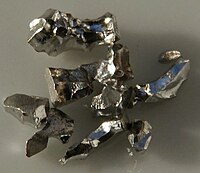
Photo from wikipedia
Devices based on deep-blue emitting iridium(III) complexes with N-heterocyclic carbene (NHC) ligands have recently been shown to give excellent performance as phosphorescent organic light-emitting diodes (PHOLEDs). To facilitate the design… Click to show full abstract
Devices based on deep-blue emitting iridium(III) complexes with N-heterocyclic carbene (NHC) ligands have recently been shown to give excellent performance as phosphorescent organic light-emitting diodes (PHOLEDs). To facilitate the design of even better deep-blue phosphorescent emitters, we carried out density functional theory (DFT) calculations of the lowest triplet (T1) potential-energy surfaces upon lengthening the iridium-ligand (Ir-C) bonds. Relativistic time dependent DFT calculations demonstrate that this changes the nature of T1 from a highly emissive metal-to-ligand charge transfer (3MLCT) state to a metal centered (3MC) state where the radiative decay rate is orders of magnitude slower than that of the 3MLCT state. We identify the elongation of an Ir-C bond on the NHC group as the pathway with the lowest energy barrier between the 3MLCT and 3MC states for all complexes studied and show that the barrier height is correlated with the experimentally measured nonradiative decay rate. This suggests that the thermal population of 3MC states is the dominant nonradiative decay mechanism at room temperature. We show that the 3MLCT → 3MC transition is reversible, in marked contrast to deep-blue phosphors containing coordinating nitrogen atoms, where the population of 3MC states breaks Ir-N bonds. This suggests that, as well as improved efficiency, blue PHOLEDs containing phosphors where the metal is only coordinated by carbon atoms will have improved device lifetimes.
Journal Title: Inorganic chemistry
Year Published: 2018
Link to full text (if available)
Share on Social Media: Sign Up to like & get
recommendations!